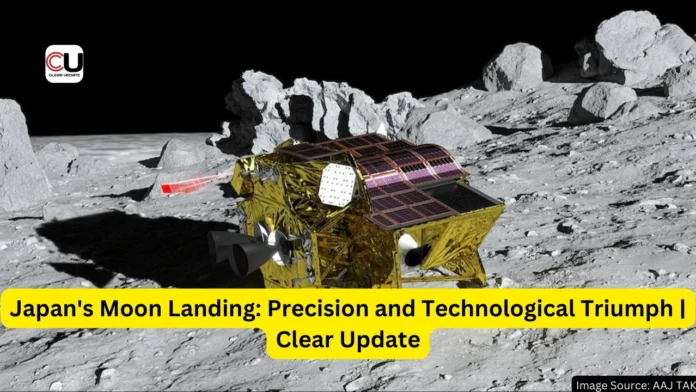In a historic milestone, Japan has etched its name into the annals of space exploration by achieving what only four other nations have done before – successfully landing a spacecraft on the Moon. The Japan Aerospace Exploration Agency (JAXA) accomplished this remarkable feat with its Smart Lander for Investigating Moon (Slim) probe, aptly nicknamed the “Moon Sniper.”
Precision Landing: A Technological Marvel
The Slim probe made a soft landing on the slope of a lunar crater just south of the equator, showcasing Japan’s prowess in “pinpoint technology.” This precision is unprecedented, with the craft touching down within a mere 100 meters (330 feet) of its intended spot. Such accuracy surpasses the standard landing zones of several kilometers observed in previous lunar missions by other nations.
Shinichiro Sakai, JAXA’s SLIM project manager, emphasized the significance of this achievement, stating, “No other nation has achieved this. Proving Japan has this [pinpoint] technology brings us a huge advantage in upcoming international missions like Artemis.” This pinpoint technology, previously employed successfully in landing probes on two asteroids, positions Japan as a frontrunner in future lunar explorations.
Read Also: ISRO chief says: Aditya-L1 इस तारीख को अपने अंतिम गंतव्य तक पहुंचने के लिए तैयार है | Clear Update
A Gateway to Future Lunar Exploration
JAXA highlights the potential of its high-precision technology as a potent tool for exploring the hilly Moon poles, considered rich in resources such as oxygen, fuel, and water. This success represents a pivotal moment for Japan, marking a turnaround from two failed lunar missions and recent rocket setbacks, including post-takeoff explosions.
Read Also: ISRO का 2024 का मिशन: 1 जनवरी को ब्लैक होल का पता लगाने के लिए XPoSat लॉन्च किया | Clear Update
The Slim Probe’s Payload: Mini-Probes Unveil Lunar Secrets
Upon landing, Slim is set to deploy two mini-probes – a hopping vehicle comparable in size to a microwave oven and a baseball-sized wheeled rover. These miniaturized marvels are equipped to capture detailed images of the spacecraft and its surroundings. Developed through a collaboration involving tech giant Sony Group, toymaker Tomy, and various Japanese universities, these robots exemplify Japan’s multidisciplinary approach to space exploration.
Japan’s Growing Influence in the Space Arena
Japan’s successful foray into lunar exploration symbolizes its increasing role in the global space landscape. Collaborating closely with the United States, Japan aims to counterbalance China’s military and technological prowess, particularly in space activities. The nation boasts a burgeoning private-sector space industry and aspires to contribute significantly to NASA’s Artemis program by sending its astronaut to the Moon.
In contrast, Japan’s recent space endeavors stand out against India’s triumph in space exploration. Last August, India’s Chandrayaan-3 achieved a historic touchdown on the Moon’s south pole, showcasing the country’s technological prowess in negotiating challenging lunar terrains.
Read Also: Samsung Galaxy A05s | Specifications | DRT
Future Collaborations: Japan and India’s Lunar Exploration Partnership
Looking ahead, Japan is poised to enhance its collaboration with India in space exploration. The two nations plan a joint unmanned lunar polar exploration mission slated for 2025. This collaborative effort not only underscores the cooperative spirit in international space exploration but also positions Japan and India as key players in unraveling the mysteries of the lunar landscape.
In conclusion, Japan’s successful Moon landing with the Slim probe is a testament to the nation’s precision technology and commitment to advancing space exploration. This achievement not only sets Japan apart as the fifth nation to accomplish this feat but also positions it as a formidable contender in future lunar missions and international collaborations. As Japan’s influence in space grows, its partnership with India in exploring the lunar frontier promises exciting discoveries and advancements in the years to come.





[…] Read Also: Japan’s Historic Moon Landing: A Big Win For Japan | Clear Update […]
[…] Read Also: Japan’s Historic Moon Landing: A Big Win For Japan | Clear Update […]